Awakening moment: how the buds of different trees open. From the life of our deciduous trees and shrubs in early spring - spring and autumn in the life of plants
Birch Song"Of all the trees in the Russian forest, our birch is sweetest to me. Birch light groves are nice and clean. Birch trunks covered with thin birch are white. The birch forest is especially good in spring.
As soon as the snow melts in the forest, resinous fragrant buds swell on birches. From each accidentally broken branch of a birch droplets a life-giving sweet juice.
Many migratory songbirds gather in birch groves. Vocal thrushes sing, cuckoos cook, nimble tits fly from tree to tree. Blue and white snowdrops-coppices spread under the birch under the birches, carpeted.


In hot summer days it is good to roam in a birch grove. A warm wind rustles above the head with green foliage. It smells of mushrooms, ripe fragrant strawberries.
Through dense foliage break through sun rays. It’s good to lie in the clean grass with your hands beneath your head and look high, where, above the peaks of birches in the blue summer sky, they are floating and floating, like white swans, tall clouds.
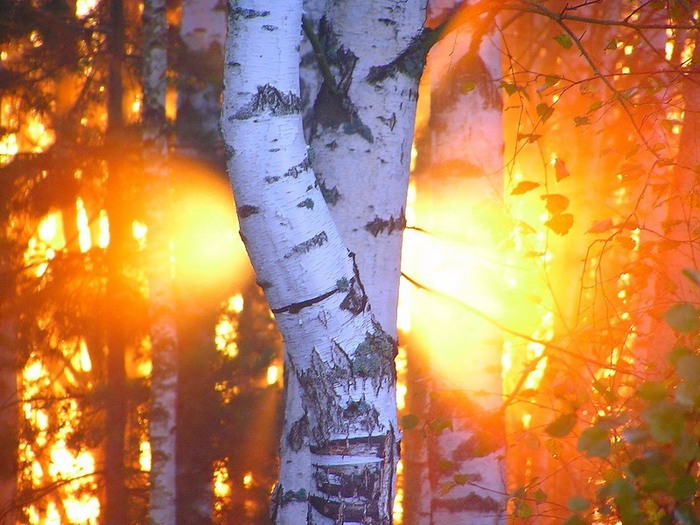
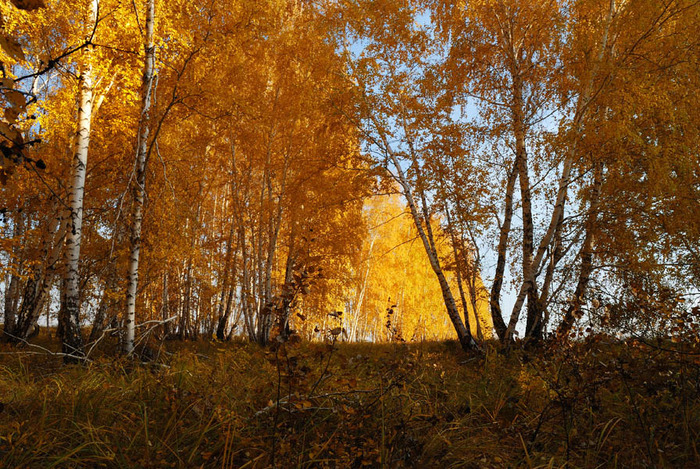
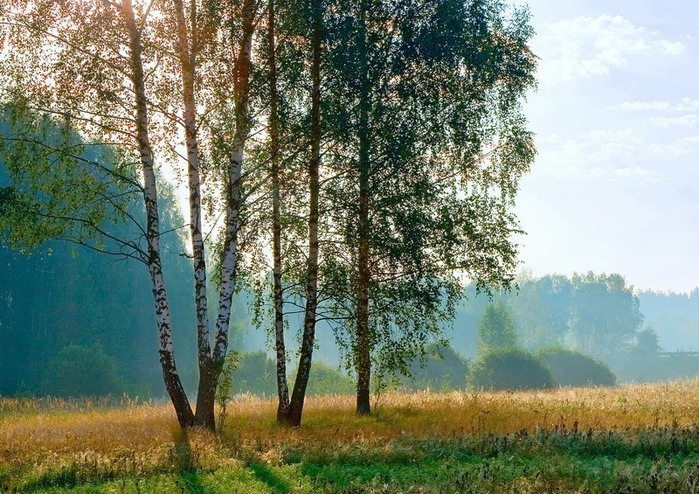
There is a special day in Russian nature when young foliage begins to blossom on birches. You will go out into the wild and gasp joyfully: forest edges covered with a gentle green haze.
Sticky tender leaves smell in a birch grove. How good are young birch leaves! Entering the forest, a person feels the fresh breath of the awakened earth. A day or two will pass - and all the birches will be covered with young thick, fresh foliage.


The birch forest covered with golden fading foliage is also wonderful in early autumn. Spinning in the air, golden leaves fall to the ground. From tree to tree, thin sticky threads of silver web are stretched. The air is transparent and clear, the slightest sound is heard in a birch forest.
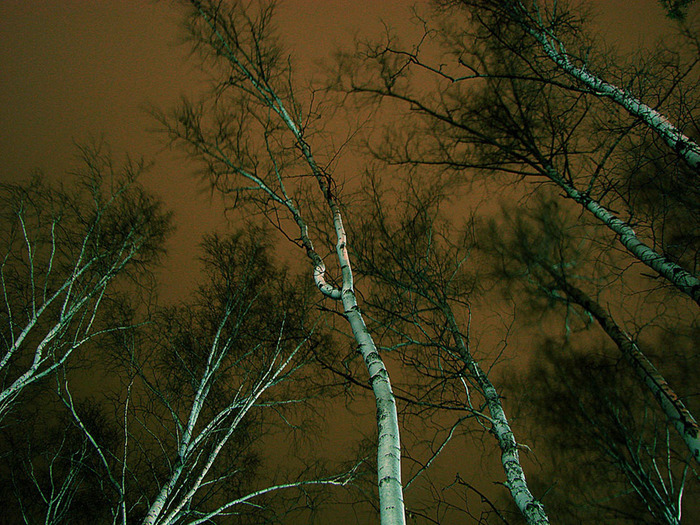
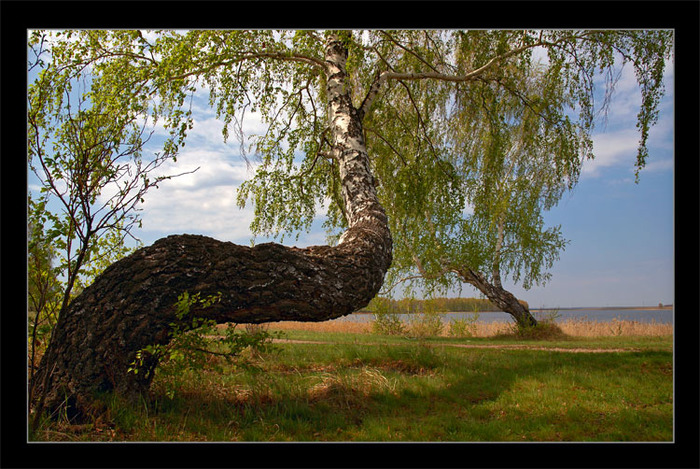
Folk songs and tales often mentioned birch. Simple village people affectionately called a birch a birch. On festive summer days, the girls curled wreaths from the branches of young birches, sang round-bang songs under birches.
In the old days, big carriageways - big trees, were planted with birches. From bark of birches in the north of our country light bast shoes were woven, comfortable wallets in which they wore clothes and water for distant reapers. From the bark of birches they drove fragrant tar, made beautiful tall tueski. "
According to I. S. Sokolov - Mikitov
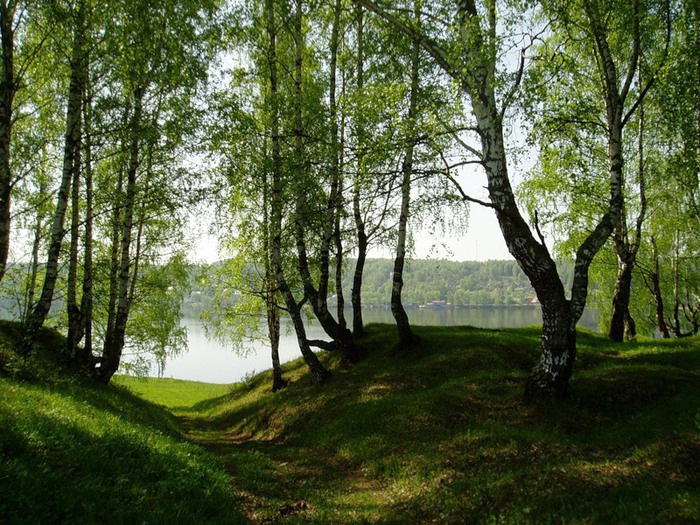
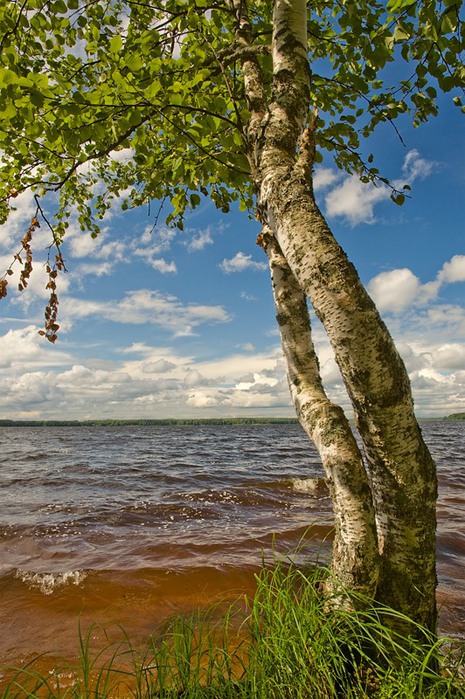
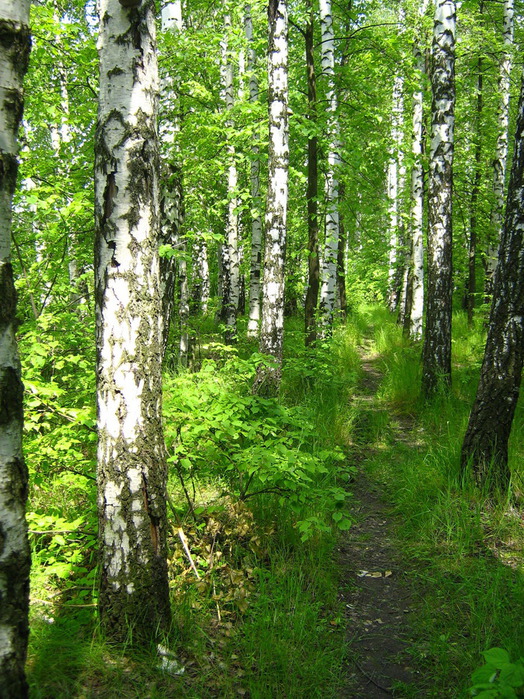
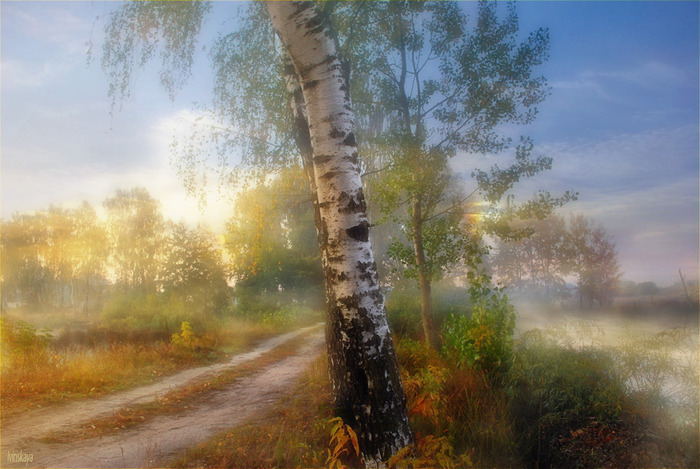
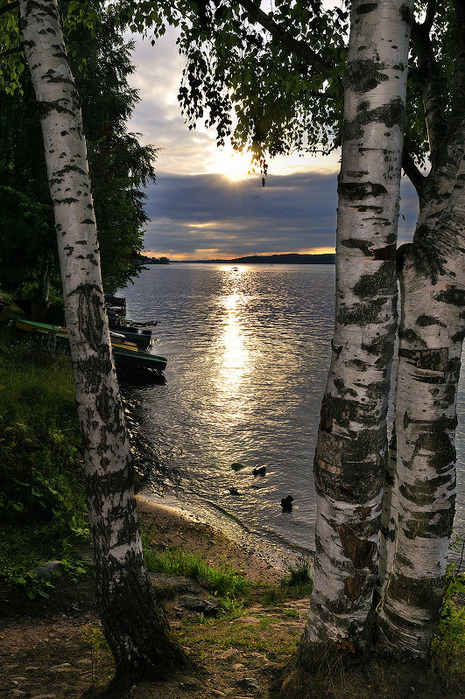

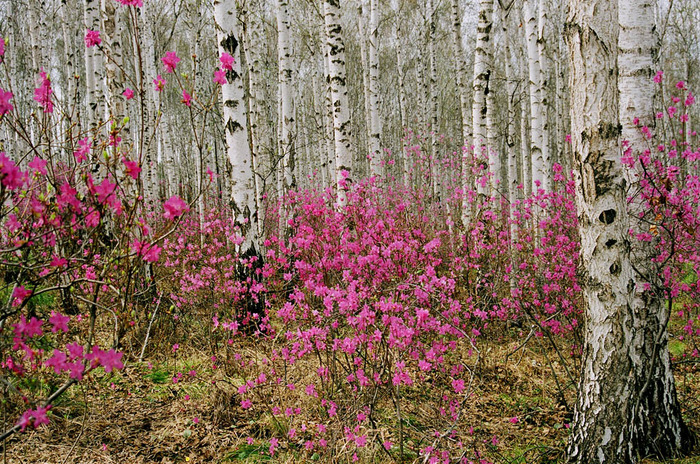
With a sharp poleax, a birch was wounded, Tears rolled down the silver bark ... And K. Tolstoy
Tea and coffee are delicious to drink with sugar. But where to find sugar in the northern forest? Sugarcane grows in tropical swamps. In hot countries, dates and other sweet berries grow. Even wild beets, and that grows only on the shores of the Mediterranean Sea. But it would not satisfy us, since it contains no more than 2 percent sugar.
In the spring, as soon as the earth dries, it is good to make the first trip to nature. And nature, as if washed, so fresh, bright, odorous!
At the edge of the forest between willow bushes and alder trees anemones whiten completely. Willow lamb is yellowed and begins to slightly dust. Still bare tree trunks are covered with a light pinkish haze. Spring. In the spring, an elegant birch in the silver-white bark, so bright in the sun, involuntarily attracts and pleases the eye.
When in the middle of a gloomy coniferous forest you suddenly meet a small young grove of white-birch birches, it seems as though a gloomy forest has smiled. The sun, the spring air, the view of the reviving nature pour vivacity and joy into us.
The leaf turns green young. Look, as young leaves Stand birched by birch trees, Airy green through, Translucent, like smoke. F. I. Tyutchev
White-trunked, with green curls fluttering in the wind, a cheerful birch is the most beloved Russian tree. And not without reason from ancient times all the Slavic peoples celebrated birch in the spring.
"Curly Birch" was decorated with colorful ribbons
“Curly birch” was decorated with multi-colored ribbons and round dances were carried around or dressed a cut birch in a woman’s dress and carried around the village with songs. Sometimes such a birch was represented by the most beautiful girlentwined with birch branches.

How many songs are composed by the people about birch, how many poems are devoted to it by Russian poets, how many paintings are depicted depicting birch groves!
Oh forest! oh life! Oh sunshine! Oh fresh birch spirit! A.K. Tolstoy
In early spring, as soon as water begins to flow into the birch root, starch reserves deposited in the roots and trunk turn into sugar, which begins to dissolve in water and rise through the vessels of wood to the kidneys. The kidneys, eating a sugar solution, bloom, growing into young shoots. In the spring, until the sticky leaves bloomed from the buds, the birch gave us sweet juice.
In the trunk of a young birch a small hole is drilled with a nail or an awl. The hole (tray) of birch bark is tightly inserted into the hole. Birch sap will drip over the popcorn. Up to ten bottles can be collected from a tree per day. In spring, one tree can produce up to four buckets.
Do not make large holes in the birch trunk.
Do not be like an evil boy destroying trees aimlessly.
Once you have collected the right amount of birch sap, cover the hole with wax.
Birch sap - sweet, slightly sour - can be evaporated to thicken to a syrup containing 60 percent sugar. This syrup has a lemon yellow color and honey density. In the forest you can get "sparkling water": if you put sugar in a glass with birch sap, the juice will foam. To keep the juice for the future, it is bottled (it is good to put two teaspoons of sugar in each bottle) and placed in the cellar.
In Belarus, kvass is made from birch sap, which is harvested there in barrels. A bag of burnt rye bread crusts is lowered on a rope into a barrel of birch sap. After two days, the yeast will pass from the crusts to the juice and fermentation will begin. Then a bucket of oak bark is poured into the barrel as a preservative (tanning) agent, and for the aroma - cherries and dill stalks. The barrel is clogged. In two weeks, kvass is ready; it can last a whole winter.
In addition to birch sap, birch buds and young leaves can be eaten in spring. They contain up to 23 percent of protein substances, up to 12 percent of fat and, most importantly, anti-zingotic substances.
When collecting buds, pay attention to the hanging earrings: green - with pistil flowers and yellow - with stamen.
Birch blooms in April - May. In July - August, small nuts with two light wings sprinkle with birch trees.

Scattered birch seeds inhabit felling areas and new areas as pioneers of woody vegetation.
Birch leaves at the edges have holes - water stomata; water with dissolved sugar seeps through them, which sometimes stands out in the form of brilliant crystals on a hot day. Sugar droplets called "honey dew" are collected by bees.
Birch has long been widely used by man. This is stated in an old riddle:
"There is a tree, green in color; in this tree there are four lands:
- the first is for sick people (bath broom),
- the other is light from the darkness (torch),
- the third - decrepit swaddling (binding of birch bark pots),
- and the fourth is a well for people (birch sap). "
The best firewood is birch. The strongest stocks, axes, wheels and other wooden products are made of birch.
Dry distillation produces acetic acid from wood, and tar and soot for paint from birch bark (can be calcined in a retort or flask). From birch bark make dishes and jewelry on caskets.
The scientific name for birch is Betula alba: “alba” is “white”, and “betula” comes from the Latin word “batuere”, which means “cut”. There are two types of white birch: fluffy and warty. In peat bogs, low birch grows (Betula humilis). Birch branches have been used since ancient times as a "cure" against disobedience.
In one of the first Russian primers, published in 1697, the following lines are devoted to the praise of birch branches:
The rod delights the mind, excites the memory, and proposes the evil will for good.
Punishment in schools remained in almost all countries until the beginning of the 20th century.
Birch forests (groves) are widespread in the forest and forest-steppe zones of our country and are in most cases secondary, resulting from forest fires or deforestation. Several types of birch trees can grow together in birch groves. Forests from warty birch, or hanging, are confined to drier habitats, and from fluffy birch to more moist ones. In the forest zone, birch forests as a result of settlement under the canopy of indigenous tree species (for example, spruce, pine) gradually turn into birch - spruce or birch - pine and further into the indigenous types of forests. Sometimes for a long time such a phase lasts in which the main components (birch + spruce) are part of the tree tiers in equal proportions. Such a forest is called mixed.
Birch tree - small-leaved breed, photophilous, frost-resistant, undemanding to soil, 25-30 m high. Branches of adult trees are drooping, which determined one of the species names, as a result, “weeping” forms of birches arise. The stems of young shoots are brown, glabrous, with tarry warts (hence the name - warty). The trunk and large branches from above are white due to betulin, a white substance in the cells of the cork; at the base, the trunk is black and cut up by deep cracks. The bark of most species of birch is white, perfectly reflects the rays of light, scattering them around the trunk, so it is light in the birch garden even on cloudy days.
Birch blooms in May, during the deployment period of leaves. This is a monoecious plant. At the base of the trunk, birch retains a huge number of sleeping buds. After sawing a tree, overgrowth leaves the stump. The ability to shoot from sleeping kidneys lasts up to 60 - 80 years, but weakens by the age of 40. Birch - a tree is not durable and rarely lives up to 120 years or more.
Fig. 7 Birch warty, or saggy:
1 - shoot with inflorescences; 2 - escape by ripening fertility; 3 - stamen flowers; 4 - pistil flowers; 5 - the fetus.
On a birch in the early spring, even before buds open, one can observe sap flow. Solutions of plastic substances rise to the kidneys. Juice can be detected by piercing the cortex from the south - side at chest level. But one should not aimlessly inflict any wounds on trees, the protection and protection of which is everyone's duty and duty.
Aspen- deciduous tree 25-30 m high. As a frost-resistant plant, it reaches the northern border of the forest. Leaf blades of a rounded shape, unequally serrated along the edge, on long petioles, somewhat thinner in the middle and flattened from the sides in the upper part. The peculiar structure of the petiole determines the constant trembling of the leaf blades even with extremely weak winds. Male and female flowers, collected in earrings, develop on the shortened shoots of different trees. Aspen blooms in late April - early May, before the vegetative buds open, leaves appear in May. Fruits - capsules ripening in June are opened by two leaves, and seeds equipped with hairs are blown away by the wind and spread over long distances. Once on moist, loose soil, they can sprout immediately; otherwise the seeds quickly lose their germination.
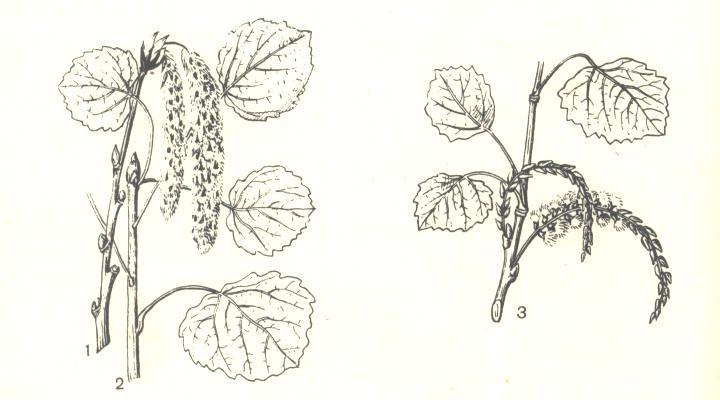
Fig. 8 Aspen
1 - shoot with male inflorescences; 2 - vegetative shoot; 3 - escape with fertility.
Aspen wood, soft and light, is recognized as the best for match production. It is widely used in carpentry, used in plywood and paper industries. Aspen deserves attention as a fast-growing breed, it is recommended to grow it in treeless and water-protected areas.
In birch forests under a canopy of trees there are many different bushes. Here, mountain ash, raspberries, warty spindle tree, buckthorn. Many of them bloom and bear fruit, since there is enough light for their life (this is not observed in twilight spruce or broad-leaved forests).
Euonymus warty - shrub up to 3.5 m high, with stems covered with wart - lentils. Its bisexual flowers open in May and are pollinated by flies. An interesting biological feature of euonymus is to preserve green leaves on young plants of seed origin and root shoots during the first years of their life for a year. The manifestation of the properties of evergreen, apparently, is an echo of the properties of ancestors who lived in the warm Tertiary period. Related species of warty euonymus, growing in countries with a warm climate, and are currently evergreen. The warty spindle tree is appreciated due to the accumulation of roots and stems of gutta in the cortex. To obtain gutta-percha, euonymus is bred artificially by cuttings. At the end of summer - in autumn, the shrub looks very decorative due to the crimson - red color of the foliage and bright fruits hanging on thin stalks - small boxes, whose wings are open, and black seeds with red seedlings emerge from the fruits.
Unbreakable buckthorn - It is of interest as a plant whose buds are overwintered, being not protected by kidney scales. If the winter is warm, then in spring, when the buds unfold, the first rudiments of the leaves turn into green assimilation organs of the adult shoot. After severe winters, the first (1 - 2) leafy buds in spring can fall without growing.

Fig. 9 Plants of birch grove:
1 - hanging birch; 2 - aspen; 3 - gray alder; 4 - forest honeysuckle; 5 - warty spindle; 6 - spring chistyk; 7 - buttercup anemone; 8 - crest of Haller; 9 - common daphne; 10 - buckthorn brittle; 11 - bone; 12 - a tenacious creep.
Buckthorn is a medicinal plant (laxatives), but it is not recommended for landscaping, since rust develops on its leaves - a mushroom that affects oats.
Ground grass cover may be different.
The spruce or pine forests that were at this place leave typical grasses for a long time, and from them one can judge the past of this site. So, on sandy soils, where there was once a pine forest, hairy hawk, sticking whitebird, Veronica officinalis, bracken fern, and other grasses characteristic of pine forests remain in the birch grove. If there are a lot of green mosses in the grass cover and sorrel, lichen bifolia, etc. are found, then it can be assumed that in the past spruces grew on this place (old spruce stumps, covered with patches of sour acid, are often found under the canopy of birches).
In deciduous forests, one can also find: Kashubian buttercup, European hoof, starfish, creeper tenacious, May lily of the valley, yellow Zelenchuk, common chickweed, sedge, hairy, perennial perennial, medicinal, four-leafed crow's eye, spring nomad.
Creeping tenacious - a perennial herbaceous creeper-root plant with renewable shoots. A plant with a wide ecological amplitude, grows in deciduous and coniferous forests, at the edges, along shrubs, in meadows.
A notable feature is the formation of creeping shoots that form in the spring. In the year of transition to flowering, 1-2 pairs of small leaves unfold at the base of the shoot and usually two pairs on an elongated stem, at the top of which a complex inflorescence is formed. An outlet in winter is green. The duration of stay of the shoot in the vegetative state is influenced by external conditions and its age state, for example, in the vegetative state, the rosettes of an aging organism die off.
Interesting plant deciduous forest is an peter cross.
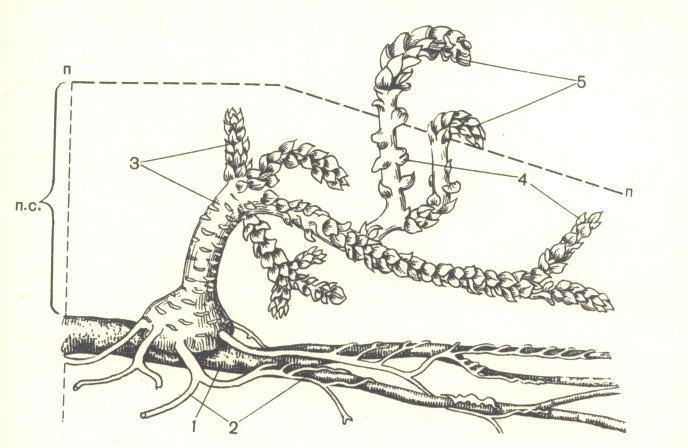
Fig. 10 Petrov cross on the roots of hazel:
3 - branched rhizome;
4 - scaly leaves;
5 - overhead shoots.
The whole plant is devoid of green color. In the soil there is a branched rhizome, densely covered with scaly leaves, and only in early spring, for a short time, an inflorescence appears above the surface of the soil - a thick one-sided brush. The flowers are pink - gray in color. Very small seeds are carried by the wind.
Willow, or willowbelongs to the willow family. This family also includes, for example, poplar and aspen. They are wind-pollinated plants, that is, pollen from their male flowers is carried and reaches female flowers through the wind. Usually wind-pollinated plants bloom long before the leaves bloom, while the foliage does not interfere with air flow and does not trap pollen. Since they do not need to attract insects, they do not secrete nectar and they do not need to care about the beauty of the flowers: their flowers are usually small and nondescript, collected in inflorescences-earrings. But they form a huge amount of pollen - much more than insect pollinated. The pollen grains of wind-pollinated plants are light, therefore, are well tolerated by the wind. In some years, whole clouds of pollen can be observed in the air in spring. different types willow
However, willows are very unusual plants. Despite the fact that they have all the signs of wind-pollinated plants, they are still an exception to the rule. Although the processes of awakening in their flower buds begin already in late January, and they bloom before all other plants in our strip, willows are the most valuable honey plants! Willow is a real salvation for bees and bumblebees in early spring, when there are no other sources of nectar in nature. Insects are attracted, on the one hand, by fragrant nectar, and on the other, by a large amount of pollen, which densely clings to the earrings during the flowering period.
Therefore, it is currently believed that willows are secondarily adapted for pollination with insects, and this adaptation could have occurred relatively recently. This is indicated, among other things, by a large number of species of insects visiting willow flowers. These are bumblebees, and bees, and butterflies, and some flies. The fact is that the flowers of most insect-pollinated plants are strictly adapted to a certain species or a certain group of insects. And such a diverse assortment of pollinating insects suggests that willows do not have much specialization in this direction.
In April-early May, on the beautiful red-brown shoots of willow (for which it is also popularly called krasnotalom) a reddish thin film bursts on the flower buds, and grayish-white fluffy lumps appear. These are male willow flowers collected in earrings. When these flowers bloom, the stamens stretch out on long stamen strings, at the end of which are yellow clumps - anthers. They form pollen. At this time, the fluffy lumps of grayish become yellow, looking like tiny chickens.

Why willow inflorescences are fluffy? The structure of willow flowers is also associated with the timing of its flowering. Willow flowers have no perianth, that is, petals and sepals. They are covered with only one scale in the bosom, in which two stamens are located. The upper part of the scale is covered with numerous long hairs, which give the still unbroken earring a characteristic fluffy appearance. These hairs, like a fur coat, put on a bud and protect it from low temperatures and sharp temperature fluctuations at a time when the cap that covers it falls off.
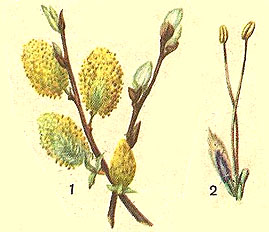
Inflorescences and flowers of male willow flowers:
1 - stamen inflorescence, 2 - stamen flower.
Female willow catkins, like other species of willow, are grayish-green, oblong and are located on other willow trees - not on those that delight the eye with spring fluffies.
Plants in which male and female flowers are on different individuals are called dioecious.

The structure of the female flowers of the willow is similar to the structure of the male, except for the fact that instead of the stamens there is an oblong ovary thickened downwards. It resembles a bottle in shape. The ovary at the top goes into a column with a bifid stigma. The sticky surface of the stigma catches pollen falling on it.
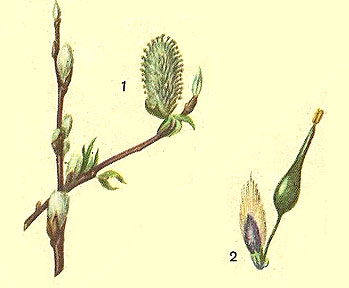
Inflorescences and flowers of female willow flowers:
1- pistil inflorescence; 2 - pistil flower.
The seeds of red willow (willow) will ripen in May-June.
Unfortunately, willows, and with them insects that feed on their pollen and nectar, in spring suffer greatly from the invasion of people in anticipation of great Christian Holiday - Palm Sunday . Most branches are broken down in the vicinity of cities and villages, where there are so few willows. From luxurious shrubs, often only miserable twigs remain. Therefore, please, when preparing for the holiday, do not forget that the willow is not just a decoration for the holiday, it is a living tree, an important part of the ecosystem that needs to be preserved. Do not pick up too many branches. After the holiday, take a couple of twigs from a jar of water and plant in the ground - they are perfectly rooted! May willows always delight us in the spring with their fluffy lamb!
